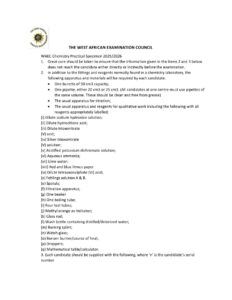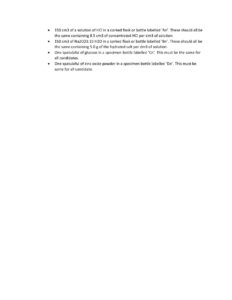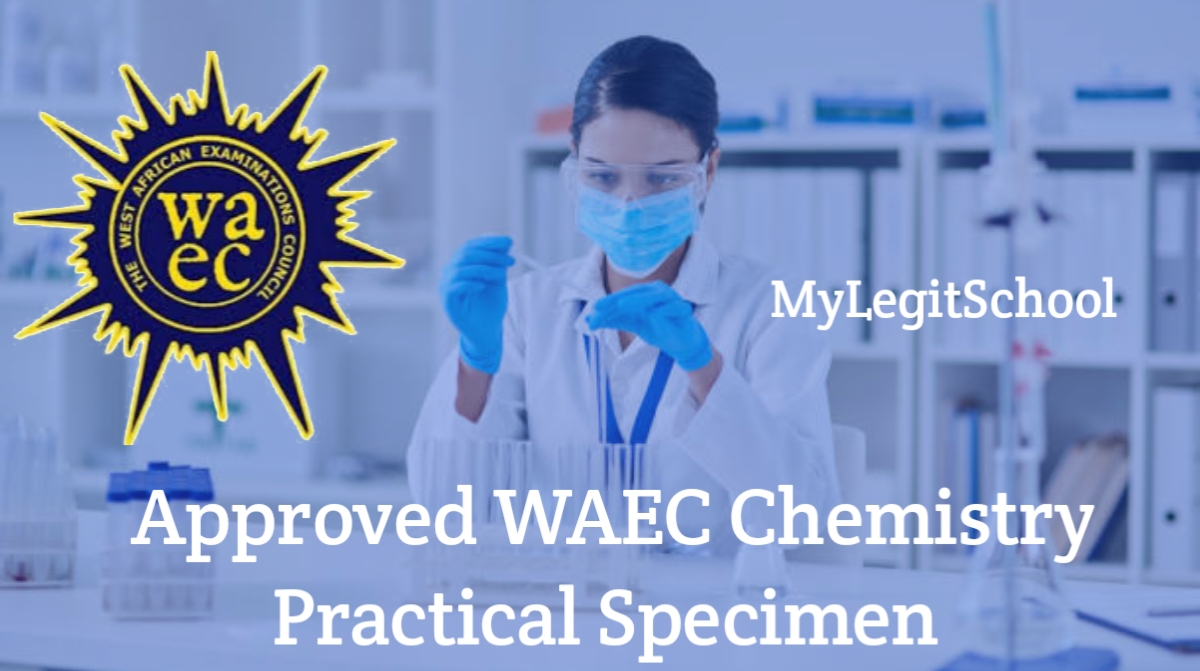WAEC Chemistry Practical Specimen 2025/2026: Are you preparing for the 2025 WAEC Examination? Do you want to know the list of specimen for WAEC Chemistry practical? If yes then keep reading, because u are at the right page.
Knowing the right the WAEC Chemistry Practical Specimen is the first step to get a good grade in your biology Examination, so if you want an excellent Grade in your Chemistry Exam then makes.
Meaning Of Chemistry Practical Specimen
Chemistry Practical Specimen comprises of the list of Materials to be used for chemistry practical exam and it is specified by WAEC board to be used in WAEC Chemistry examination.
Question are asked from the List of specimen provided, so it is very important for all WAEC student who are taking chemistry exam to know these specimen/materials.
WAEC 2025 Chemistry Practical Specimen
Below are the list of Chemistry Practical Specimen for Alternative A
Alternative A (WAEC Chemistry Practical Specimen)
- Great care should be taken to ensure that the information given in the items 2 and 3 below does not reach the candidate either directly or indirectly before the examination.
- In addition to the fittings and reagents normally found in a chemistry laboratory, the following apparatus and materials will be required by each candidate:
- One burette of 50 cm3 capacity;
- One pipette, either 20 cm3 or 25 cm3. (All candidates at one centre must use pipettes of the same volume. These should be clean and free from grease)
- The usual apparatus for titration;
- The usual apparatus and reagents for qualitative work including the following with all reagents appropriately labelled;
-
-
- (i) Dilute sodium hydroxide solution;
- (ii) Dilute hydrochloric acid;
- (iii) Dilute trioxonitrate
- (V) acid;
- (iv) Silver trioxonitrate
- (V) solution;
- (v) Acidified potassium dichromate solution;
- (vi) Aqueous ammonia;
- (vii) Lime water;
- (viii) Red and blue litmus paper
- (ix) Dilute tetraoxosulphate (VI) acid;
- (x) Fehlings solution A & B.
- (e) Spatula;
- (f) Filtration apparatus;
- (g) One beaker
- (h) One boiling tube;
- (i) Four test tubes;
- (j) Methyl orange as indicator;
- (k) Glass rod;
- (l) Wash bottle containing distilled/deionized water;
- (m) Burning splint;
- (n) Watch glass;
- (o) Bunsen burner/source of heat;
- (p) Droppers;
- (q) Mathematical table/calculator.
-
- Each candidate should be supplied with the following, where ‘n’ is the candidiate’s serial number
- 150 cm3 of a solution of HCl in a corked flask or bottle labelled ‘An’. These should all be the same containing 8.5 cm3 of concentrated HCl per dm3 of solution.
- 150 cm3 of Na2CO3.10 H2O in a corked flask or bottle labelled ‘Bn’. These should all be the same containing 5.0 g of the hydrated salt per dm3 of solution.
- One spatulaful of glucose in a specimen bottle labelled ‘Cn’. This must be the same for all candidates.
- One spatulaful of zinc oxide powder in a specimen bottle labelled ‘Dn’. This must be same for all candidate


Important Notice
All Schools are to provide the above listed material available before the day of examination.
Also Read
- Approved WAEC 2025 Timetable for Science Student | Download Now!
- Approved WAEC 2025 Timetable for Art and Commercial Student
Alternative B (WAEC Chemistry Practical Specimen)
(a) One Burette of 50cm3 of capacity
(b) One pipette, either 20cm3 or 25cm3 (All candidates at one center must use pipettes of the same volume, these should be clean and free from grease).
(c) The usual apparatus for titration
(d) The usual apparatus and reagents for qualitative work including the following with all reagents appropriately labeled:
(i) dilute sodium hydroxide solution
(ii) dilute hydrochloric acid
(iii) dilute trioxonitrate(v) acid
(iv) silver trioxonitrate(v) solution
(v) aqueous barium chloride
(vi) aqueous ammonia
(vii) lime water
(viii) red and blue litmus paper
(ix) dilute tetraoxosulphate(vi) acid
(x) acidified potassium dichlorate solution.
(e) Spatula
(f) Filtration apparatus,
(g) One beaker
(h) One boiling tube
(i) Four test tubes
(j) methyl orange indicator
(k) Glass rod
(l) Wash bottle containing distilled/deionized water,
(m) Burning splint,
(n) Watch glass
(o) Bunsen Burner/source of heat
(p) Droppers
(q) mathematical table/calculator
(r) phenolphthalein indicator
Topics To Read for WAEC Chemistry Practical Exam 2025
Below are the list of topics to read for the 2025 WAEC Practical Exam.
Qualitative Analysis (Salt Analysis)
- Identification of cations (e.g., NH₄⁺, Pb²⁺, Fe²⁺, Fe³⁺, Cu²⁺, Zn²⁺, Al³⁺, Ca²⁺)
- Identification of anions (e.g., CO₃²⁻, SO₄²⁻, NO₃⁻, Cl⁻, Br⁻, I⁻, SO₃²⁻)
- Use of reagents like NaOH, NH₃, HCl, BaCl₂, AgNO₃, etc.
- Observation of color changes, precipitates, and gas evolution.
Volumetric Analysis (Titration)
- Acid-base titrations (e.g., HCl vs NaOH, H₂SO₄ vs Na₂CO₃)
- Redox titrations (e.g., KMnO₄ vs Fe²⁺, Iodine vs Thiosulfate)
- Calculations involving molarity, mole ratio, and concentration.
- Proper use of burettes, pipettes, and indicators (phenolphthalein, methyl orange).
Quantitative Analysis
- Gravimetric analysis (e.g., precipitation and weighing of salts)
- Determination of water of crystallization.
- Calculations involving percentage purity and yield.
Rate of Reaction & Chemical Kinetics
- Effect of concentration, temperature, and catalysts on reaction rates.
- Experiments like the reaction between sodium thiosulfate and HCl.
Thermochemistry (Enthalpy Changes)
- Determination of heat of neutralization, solution, or displacement.
- Calculations using Q = mcΔT.
Electrochemistry
- Simple voltaic cells (e.g., Zn-Cu cell).
- Electrolysis experiments (e.g., CuSO₄ using carbon electrodes).
Organic Chemistry Tests
- Tests for functional groups (e.g., alkenes, alcohols, carboxylic acids).
- Ferric chloride test for phenols.
- Iodoform test for ketones and ethanol.
Solubility & Crystallization
- Separation techniques (filtration, crystallization, distillation).
- Solubility curves and salt preparation.
Gas Tests
- Identification of gases like CO₂, H₂, O₂, NH₃, SO₂, and Cl₂
Conclusions
We have reached the end of this Post, we hope you find this Post Helpful.
For more information or questions about WAEC Chemistry Specimen do well to leave us a comment in the comments box below.
For All KIND OF WAEC HELP YOUCAN CLICK THE LINK BELOW TO JOIN OUR WHATSAPP GROUP
Share This Post: If this post helped you, share it with others!
Recommended Post
- WAEC chemistry Specimen
- WAEC Biology Specimen
- WAEC Physic Specimen
- WAEC Agric Specimen
- WAEC Animal Husbandry Specimen
- WAEC Fishery Specimen
- WAEC Technical Drawing Specimen
- WAEC Computer Studied Specimen
- WAEC Visual Art Specimen


Thank you sir